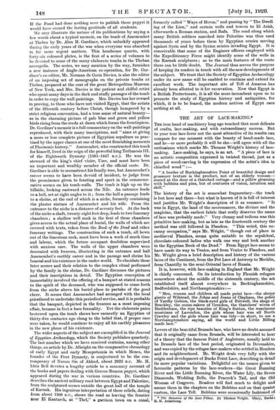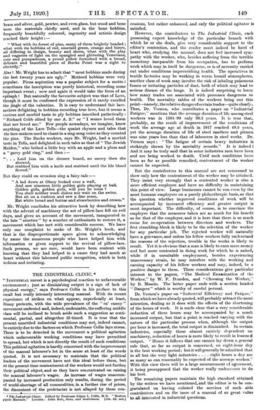THE ART OF LACE-MAKING.'
THE iron hand of machinery long ago touched that most delicate of crafts, lace-making, and with extraordinary success. But
to your true lace-lover not the most attractive of its results can compare for one moment with the beauty of hand-made lace, and he—or more probably it will be she—will agree with all the enthusiasm which marks Mr. Thomas Wright's history of lace- making. Lace-making, he says, is an art. " A piece of lace is an artistic composition expressed in twisted thread, just as a piece of wood-carving is the expression of the artist's idea in chiselled wood " :-
" A border of Buckinghamshire Point of beautiful design and gossamer texture is the product, not of an elderly woman— seated at the door of a thatched cottage—and a pillow gleaming with bobbins and pins, but of centuries of vision, intuition and skill."
The history of the art is somewhat fragmentary—the track is lost here and there—but what is known of it is full of interest and justifies Mr. Wright's description of it as romance. " It was in Egypt, the land of the necromancer, the diviner and the magician, that the earliest fabric that really deserves the name of lace was probably made." Very clumsy and tedious was this primitive lace-making, but as late as the fourteenth century the method was still followed in Flanders. " This weird, this un- canny occupation," says Mr. Wright, " though out of place in mediaeval Flanders, seems quite suitable to the sepulchral, chocolate-coloured ladies who walk one way and look another in the Egyptian Book of the Dead." From Egypt lace seems to have made its way to Venice, and from Venice to Flanders, and Mr. Wright gives a brief description and history of the various laces of the Continent, from the Pot Lace of Antwerp to Mechlin, from Chantilly to the semi-Oriental laces of Russia.
It is, however, with lace-making in England that Mr. Wright is chiefly concerned. On its introduction by Flemish refugees somewhere about the middle of the sixteenth century, the art established itself almost everywhere in Buckinghamshire, Bedfordshire, and Northamptonshire :—
" Men, women and children all made point lace—the sleepy giants of Wilstead, the Johns and Jeans of Clapham, the gokes of Yardly Gobion, the black-eyed girls of Fritwell, the skegs of Brackley, the moon-rakers of Grendon, the thatchers' wives of Haddenham, the ripe beauties of King's Sutton, the wearisome musicians of Lavendon, the girls whose hair was all North Crawley and the girls whose hair was tidy—in short, to use a Northamptonshire saying, all the world and Little Billing made lace."
Lovers of the beautiful Brussels lace, who have no doubt assumed that it originally came from Brussels, will be interested to hear of a theory that the famous Point d' Angleterre, usually held to be Brussels lace of the best period, originated in Devonshire, and was copied by the refugee lace-makers who settled in Honiton and its neighbourhood. Mr. Wright deals very fully with the origin and development of Bucks Point Lace, describing in detail its more popular variations. Delightful are the names Oven to favourite patterns by the lace-workers—the Great Thinning River and the Little Running River, the Water Lily, the Seven Diamonds, Wedding Bells, the Peacock's Tail, and the Old Woman of Cosgrove. Readers will find much to delight and amuse them in the chapters on the Bobbins and on that quaint custom, the Lace Tell. Bobbins were occasionally fashioned of
• The Romance of the Lace Pillow. By Thomas Wright. Olney. Bucks;
H. U. Armstrong. brass and silver, gold, pewter, and even glass, but wood and bone were the materials chiefly used, and in the bone bobbins, frequently beautifully coloured, ingenuity and artistic design reached their height :— " What with its forest of pins, many of them brightly beaded ; what with its bobbins of red, emerald green, orange and bistro, all differing in design, beauty and sheen, what with the play and vagaries of light on the spangled and glittering Venetians, cuts and pompadours, a proud pillow furnished with a broad, delicate and beautiful piece of Bucks Point was a sight to electrify."
Alas ! Mr. Wright has to admit that " most bobbins made during the last twenty years are ugly." Mottoed bobbins wore very popular. Pious aspiration was a popular subject for a motto ; sometimes the inscription was purely historical, recording some important event ; now and again it would take the form of an epitaph ! But naturally the favourite subject was that of Love, though it must be confessed the expression of it rarely excelled the jingle of the valentine. It is easy to understand fair lace- makers delighting in bobbins recording true love, but it seems a curious and morbid taste to ply bobbins inscribed pathetically : " Richard Cobb slited by one A. S." or " I wonce loved them that ner loved me." Few people nowadays, we imagine, know anything of the Lace Tells—the quaint rhymes and tales that
the lace-makers used to chant in a sing-song voice as they counted the pins. The Bucks workers, says Mr. Wright, had a morbid taste in Tells, and delighted in such tales as that of " The Jewish Maiden," who bribed a little boy with an apple and a plum and a " garry gold ring," and then
. . Laid him on the dresser board, no mercy then she showed, But stabbed him with a knife and stabbed until the life blood flowed."
But they could on occasion sing a fairy-tale :- " A lad down at Olney looked over a wall, And saw nineteen little golden girls playing at ball. Golden girls, golden girls, will you be mine ? You shall neither wash dishes nor wait on the swine. But sit on a cushion and sew a fine seam, Eat white bread and butter and strawberries and cream."
Mr. Wright concludes his attractive book by describing how with the advent of machinery the art of pillow-lace fell on evil days, and gives an account of the movement, inaugurated in the late "nineties " by a number of enthusiasts to restore it, a movement which has met with considerable success. We have only one complaint to make of Mr. Wright's book, and that is the disproportionate space given to acknowledging by name the numerous people who have helped him with information or given support to the revival of pillow-lace. Such persons, we are sure, would have been content with knowing that they had helped in a cause they had much at heart without this laboured public recognition, which is both tedious and irritating.



































 Previous page
Previous page